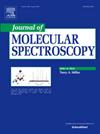关于 SbF 低洼电子态的理论研究
IF 1.3
4区 物理与天体物理
Q4 PHYSICS, ATOMIC, MOLECULAR & CHEMICAL
引用次数: 0
摘要
利用核价相关和自旋轨道耦合效应,对50000 cm−1以下单氟化锑(SbF)的低洼价态和Rydberg态的分布进行了多参考组态相互作用计算。由势能曲线推导出7个(准)束缚态Λ-S和14个(准)束缚态Ω的光谱常数,与实验值吻合较好。我们的结果表明,第二个3Π态涉及Sb的Rydberg壳层6s的占据,它解决了SbF紫外光谱中所谓的“C2”和“C31”态的分配。借助更精确的耦合簇计算,确定SbF的解离能(De)在理论极限为4.24 eV,比文献中广泛使用的经验值小0.2 eV。本文章由计算机程序翻译,如有差异,请以英文原文为准。

Theoretical study on the low-lying electronic states of SbF
Multi-reference configuration interaction calculations are carried out to elucidate the distribution of low-lying valence and Rydberg states of antimony monofluoride (SbF) below 50000 cm−1, where the effects of core–valence correlation and spin–orbit coupling have been employed. From the potential energy curves, the spectroscopic constants of seven (quasi-)bound -S and fourteen (quasi-)bound states have been derived, which agree well with the experimental values. Our results show that the second state involves the occupation on the Rydberg shell 6 of Sb, which settles the assignment of the so-called “” and “” states in the ultraviolet spectra of SbF. With the help of the more accurate coupled cluster calculations, the dissociation energy () of SbF is determined to be 4.24 eV at the theoretical limit, being 0.2 eV smaller than the widely used empirical value in the literature.
求助全文
通过发布文献求助,成功后即可免费获取论文全文。
去求助
来源期刊
CiteScore
2.70
自引率
21.40%
发文量
94
审稿时长
29 days
期刊介绍:
The Journal of Molecular Spectroscopy presents experimental and theoretical articles on all subjects relevant to molecular spectroscopy and its modern applications. An international medium for the publication of some of the most significant research in the field, the Journal of Molecular Spectroscopy is an invaluable resource for astrophysicists, chemists, physicists, engineers, and others involved in molecular spectroscopy research and practice.

 求助内容:
求助内容: 应助结果提醒方式:
应助结果提醒方式:


